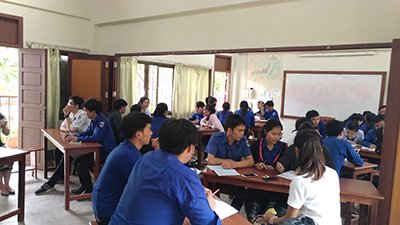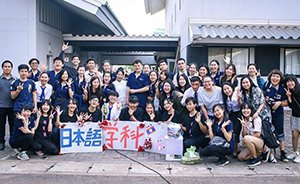2018 Japanese-Language Assistants’ Report: Looking Back on a Year in Laos
National University of Laos
KATTO Hitomi
Laos is a country where time flows as slowly as the Mekong River. I am currently working as a Japanese-Language Assistant (hereafter referred to as "Assistant") at the Department of Japanese, Faculty of Letters, National University of Laos (hereafter referred to as “Department of Japanese”) in Vientiane, the capital of Laos.
The Department of Japanese currently has a total of about 100 students in years 1-4 that study Japanese. There are ten teachers in total, eight of whom are Laotian teachers and a Japanese-Language Senior Specialist and an Assistant from the Japan Foundation. The Japan Foundation has been dispatching Assistants since 2003, and I am the third generation to be dispatched as an Assistant. In this report, I would like to introduce the Department of Japanese and the activities of the Assistant.
Why Do Students Study Japanese?
Recently, as a class activity, I asked students in years 1-3 the reasons why they had chosen to study in the Department of Japanese (multiple answers allowed. 81 out of a total of 85 students in years 1-3 responded). The top three responses were common to students in years 1-3: "because I want to work for a Japanese company in Laos" (64%), "because I want to study in Japan" (63%), and "because I am interested in Japanese culture" (54%). This shows that students in the Department of Japanese have a strong cultural, as well as practical, interest in learning Japanese.
The Role of the Assistant
The job of the Assistant in the Department of Japanese is mainly to teach classes. The table below shows the classes that I am teaching this semester. I teach mainly 1st and 2nd year students (elementary to pre-intermediate level classes), 6 lessons in 5 subjects (each lesson lasts 90 minutes).
| Monday | Tuesday | Wednesday | Thursday | Friday | |
|---|---|---|---|---|---|
| 8:00 - 9:30 a.m. | |||||
| 10:00 - 11:30 a.m. | Grammar (2nd year students) |
Grammar (1st year students) |
Grammar (2nd year students) |
||
| 11:30 a.m. - 1:00 p.m. | Lunch Break | ||||
| 1:00 - 2:30 p.m. | Composition (2nd year students) |
Listening Comprehension and Conversation (1st year students) |
|||
| 3:00 - 4:30 p.m. | Grammar (3rd year students) |
||||
The Grammar classes are taught by two or three Laotian teachers who take turns and use a designated textbook. The Assistant is responsible for creating progress charts and tests, in addition to their regular teaching duties. We have a good supply of summary tests and reference documents that have accumulated from previous generations of Japanese-Language Specialists and Assistants.
The Composition and Listening Comprehension and Conversation classes are taught only by the Assistant. Unlike the Grammar classes, these classes do not have designated textbooks, so I have to do everything myself, from selecting teaching materials, creating the syllabus, to creating and evaluating tests. It is very challenging for me, as I have little experience, but I am receiving advice from Japanese-Language Senior Specialists as I go. As I find my way forward, what I am conscious of in the classes I am entrusted with alone is to increase the opportunities for students to use Japanese as a tool. For example, in the Listening Comprehension and Conversation class, we invite Japanese guests and interview them, and in the Composition class, we have made pamphlets that introduce the Department of Japanese. Even students who seem to have difficulty in the Grammar classes participate in these classes with a gleam in their eyes.

First-year students interviewing Japanese guests in the Listening Comprehension and Conversation class
In addition, when I am not in class, I prepare for the classes and respond to students' questions and concerns. I am also in charge of speech coaching for the Japanese Speech Contest. The table below shows a rough annual schedule.
| First semester (September to January of the following year) |
Second semester (February to June) |
|---|---|
|
|
Classroom Episodes
Since classes proceed while communicating with students, many things happen that I could not have anticipated when preparing the class. I would like to share with you two of the most memorable of such episodes.
Sukiyaki?
That day, I was teaching the sentence pattern "to do ... for me" in the first-year Grammar class. After looking at the picture and practicing saying, "They made sukiyaki for me," I pointed to the picture and asked, "Have you ever eaten it? Do you have it in Laos?" The students replied, "Yes, we have. Yes, we do," but after the class, some students came up to me and asked, "Would you like to go out for sukiyaki sometime?" When I went with them afterwards, I found that it was not sukiyaki but Laotian-style barbecue. I still remember that day's lesson when I teach this sentence pattern.
"Huh?"
In Laos, when you haven't heard what the other person has said, in the same way that in Japanese you can ask "Eh?” you can ask "Huh?" When I first heard it, I thought the student was angry and I was surprised. Later, when the topic of differences in communication came up in class, the students were surprised when I told them, "When Japanese people hear 'Huh?' they think the other person is angry." Since then, even outside of class, when my students say "Huh?" when they are talking to me they immediately say, "Oh, I'm sorry!" as they remember that lesson.
These were episodes that made me happy to see that interactions in class had reached beyond the classroom.
The Atmosphere of the Department of Japanese
In the Department of Japanese, teachers, students, and teachers and students get along very well, like a family. If we have any problems, we can easily consult each other, and we always help each other. Many Laotian people are cheerful and love to talk, and when they meet teachers or students, they start chatting and sometimes forget the time. I feel very comfortable here because I can interact with the teachers and students even outside of class.

Commemorative photo of the teachers and students of the Department of Japanese taken after the Japanese Speech Contest
My Feelings After the First Year
As I mentioned above, the teachers and students in the Department of Japanese are all cheerful and warm people. However, the students still have few opportunities to use Japanese in Laos, and some students cannot maintain their motivation as they move up the school years. In my remaining year, I hope to create more opportunities for students to use Japanese in the classroom and outside the classroom.
- What We Do Top
- Arts and Cultural Exchange [Culture]
- Japanese-Language Education Overseas [Language]
- Japanese-Language Education Overseas [Language] Top
- Learn Japanese-language
- Teach Japanese-language
- Take Japanese-Language Test
- Know about Japanese-language education abroad
- The Japanese-Language Institute, Urawa
- The Japanese-Language Institute, Kansai
- Japanese-Language Programs for Foreign Specified Skilled Worker Candidates
- Japanese Language Education for Japanese Children Resident Overseas and for the Descendants of Migrants
- Archives
- Japanese Studies and Global Partnerships [Dialogue]
- JF digital collection
- Other Programs / Programs to Commemorate Exchange Year
- Awards and Prizes
- Publications
